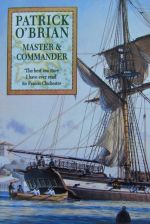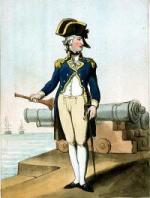MASTER AND COMMANDER, by Patrick O’Brian, originally pubished in 1969
(My copy is from the series published in the 1990s with the wonderful Gary Hunt covers – much better than models dressed up in costume, hrumpf)
Bookcase 3, shelf 7, book 24
 It had to happen sooner or later. The dice would select a book lurking in a series, one which could not be explored or explained without reading others. Or they would pick a book which started a series, and I wouldn’t be able to stop reading. There are twenty-one books in Patrick O’Brian’s astonishing Aubrey / Maturin series (If you count the one left unfinished at the author’s death), and I’ve been zooming through them, the dice having happily given me the first, Master and Commander. (And no, it’s nothing like the film with Russell Crowe, thank heavens.)
It had to happen sooner or later. The dice would select a book lurking in a series, one which could not be explored or explained without reading others. Or they would pick a book which started a series, and I wouldn’t be able to stop reading. There are twenty-one books in Patrick O’Brian’s astonishing Aubrey / Maturin series (If you count the one left unfinished at the author’s death), and I’ve been zooming through them, the dice having happily given me the first, Master and Commander. (And no, it’s nothing like the film with Russell Crowe, thank heavens.)
So what is it about these books, set in a version of Nelson’s Royal Navy during the Napoleonic Wars? Why are they so addictive? And why do they excite such passionate attachment among their fans?
It may be heresy, but I have to say it: they’re not all perfect, far from it, but M&C is a stonking start. O’Brian sweeps you straight in. The language, even the punctuation – they could belong, sometimes, to the early nineteenth century, and it comes as no surprise that O’Brian adored Jane Austen and collected early editions of her books. You don’t have to understand the nautical vocabulary (I still have absolutely no idea what a ‘dog-pawl’ is and I’m not sure I want to know), but whether you do or not, it all helps to create an atmosphere which encourages readers to become absorbed in this particular world. And O’Brian was meticulous about the language he used, incidentally – it is authentic, substantiated in all the mountains of research and contemporary accounts in which he immersed himself. But that’s not it, though it’s a part of it.
 It has to be the core relationship, the one between the comparatively straightforward and bluff Jack Aubrey RN and the considerably more enigmatic Stephen Maturin, and between them and various other characters who materialize and vanish and come back again, or who are relatively minor constants. You come to know these people: Killick the steward, Bonden the bosun, Mr Pullings – and you become involved. Will the delightful Pullings ever make captain, even though he has no ‘pull’ in the Admiralty? Will Killick stop grumbling? Who will get killed in the next engagement? Will Stephen’s spying activities mean he gets tortured again, and will he ever be able to break free from his attachment to – enough… As one reviewer noted, one key to the series’ success was that ‘times change, but people don’t.’ And the people are exceptionally well drawn, even if it is sometimes easy to forget that in all the excitement and the recreation of a vanished world.
It has to be the core relationship, the one between the comparatively straightforward and bluff Jack Aubrey RN and the considerably more enigmatic Stephen Maturin, and between them and various other characters who materialize and vanish and come back again, or who are relatively minor constants. You come to know these people: Killick the steward, Bonden the bosun, Mr Pullings – and you become involved. Will the delightful Pullings ever make captain, even though he has no ‘pull’ in the Admiralty? Will Killick stop grumbling? Who will get killed in the next engagement? Will Stephen’s spying activities mean he gets tortured again, and will he ever be able to break free from his attachment to – enough… As one reviewer noted, one key to the series’ success was that ‘times change, but people don’t.’ And the people are exceptionally well drawn, even if it is sometimes easy to forget that in all the excitement and the recreation of a vanished world.
Master and Commander is where Jack Aubrey and Stephen Maturin encounter each other for the first time; the former irritates the latter at a concert by beating time rather enthusiastically. A duel is averted when Jack is promoted and, in the consequent spirit of bonhomie, apologizes to Stephen. He then recruits the financially embarrassed Stephen as his ship’s surgeon, and that is fortunate – fortunate for us as readers, because Stephen knows very little of the ways of Nelson’s Navy, and can be an ‘interpreter’ for the rest of us, especially in the very early books. He is experiencing things like the sudden uprush of activity when the watches change for he first time, and so are we; to a certain extent we see this world mainly through Stephen’s eyes. And of course O’Brian had no idea, when he delivered the manuscript for Master and Commander, that this would be the first in a series of over twenty books that would occupy the rest of his life and define his literary reputation.
 He was already, though, a huge fan of the period and of Nelson, and it’s his knowledge of that, and his deep enthusiasm for it as well, which illuminates all of the books. Some of the action may seem exaggerated or unlikely, but there is scarcely a naval incident that isn’t based in some way on reality, and the subplots are thoroughly researched as well. The actions in which Aubrey’s ship, the Sophie, becomes involved are based on the experiences of Thomas Cochrane, and Cochrane is (largely) the model for Jack Aubrey. Maturin, it has been said, is more like the rather complex and troubled author. It’s a real achievement to take all that thorough-going research and knowledge and transform it into something as exciting and involving as Master and Commander – let alone the other books in the series.
He was already, though, a huge fan of the period and of Nelson, and it’s his knowledge of that, and his deep enthusiasm for it as well, which illuminates all of the books. Some of the action may seem exaggerated or unlikely, but there is scarcely a naval incident that isn’t based in some way on reality, and the subplots are thoroughly researched as well. The actions in which Aubrey’s ship, the Sophie, becomes involved are based on the experiences of Thomas Cochrane, and Cochrane is (largely) the model for Jack Aubrey. Maturin, it has been said, is more like the rather complex and troubled author. It’s a real achievement to take all that thorough-going research and knowledge and transform it into something as exciting and involving as Master and Commander – let alone the other books in the series.

It comes as quite a surprise now to realise how slow-burning the series was. Master and Commander wasn’t immediately picked up by a British publisher, for example, and the early reviews simply compared Jack Aubrey to Horatio Hornblower, usually to the former’s disadvantage. But slowly the word began to spread. O’Brian’s books picked up illustrious fans who weren’t afraid to sing their praises, and so the series grew into what it is today: something of a global phenomenon, if a somewhat select one. And one with something of a catching style for which I must apologize (no risk of duels, anyway)…



 Medicine is a strange mix of the rational (a truss for hernia) and treatments which appear somewhat more magical – annointing yourself with fat from a roasted cat (!), and frying beheaded dung beetles and crickets in oil to treat a bladder stone. Your doctors will want to look at your pee in order to determine what is wrong with you, by the way.
Medicine is a strange mix of the rational (a truss for hernia) and treatments which appear somewhat more magical – annointing yourself with fat from a roasted cat (!), and frying beheaded dung beetles and crickets in oil to treat a bladder stone. Your doctors will want to look at your pee in order to determine what is wrong with you, by the way.